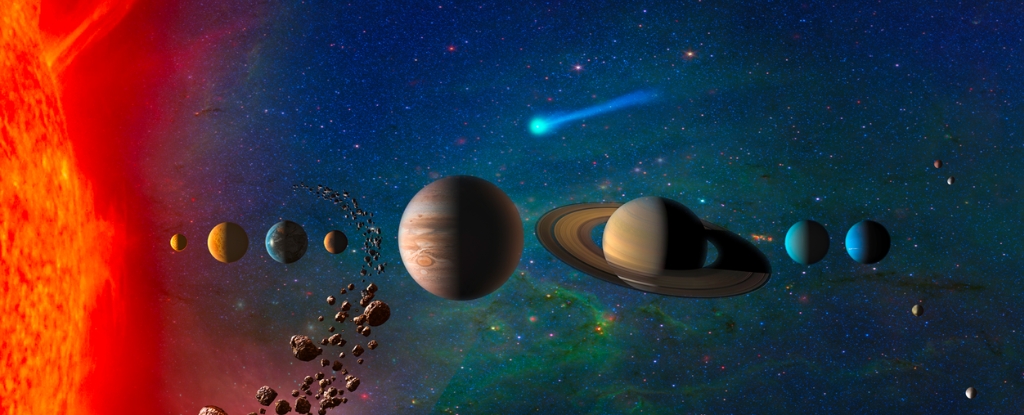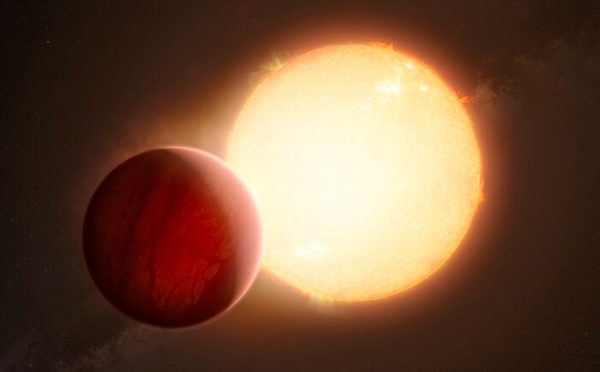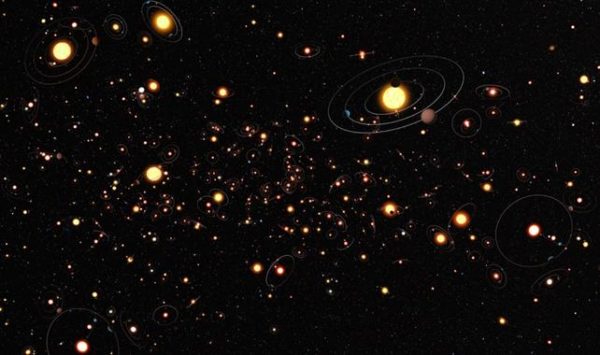
Posted on 01/03/2024 10:51:26 AM PST by Red Badger

Since the landmark discovery in 1992 of two planets orbiting a star outside of our Solar System, thousands of new worlds have been added to a rapidly growing list of 'exoplanets' in the Milky Way galaxy.
We've learnt many things from this vast catalogue of alien worlds orbiting alien stars. But one small detail stands out like a sore thumb. We've found nothing else out there like our own Solar System.
This has led some to conclude that our home star and its brood could be outliers in some way – perhaps the only planetary system of its kind.
By extension, this could mean life itself is an outlier; that the conditions that formed Earth and its veneer of self-replicating chemistry are difficult to replicate.
If you're just looking at the numbers, the outlook is grim. By a large margin, the most numerous exoplanets we've identified to date are of a type not known to be conducive to life: giants and subgiants, of the gas and maybe ice variety.
Most exoplanets we've seen so far orbit their stars very closely, practically hugging them; so close that their sizzling temperatures would be much higher than the known habitability range.
 Artist's impression of an ultra-hot Jupiter transiting its star. (ESO/M. Kornmesser)
Artist's impression of an ultra-hot Jupiter transiting its star. (ESO/M. Kornmesser)
It's possible that as we continue searching, the statistics will balance out and we'll see more places that remind us of our own backyard. But the issue is much more complex than just looking at numbers. Exoplanet science is limited by the capabilities of our technology. More than that, our impression of the true variety of alien worlds risks being limited by our own imagination.
What's really out there in the Milky Way galaxy, and beyond, may be very different from what we actually see.
Expectations, and how to thwart them Exoplanet science has a history of subverting expectations, right from the very beginning.
"If you go back to that world I grew up in when I was a kid, we only knew of one planetary system," planetary scientist Jonti Horner of the University of Southern Queensland told ScienceAlert in 2022.
"And so that was this kind of implicit assumption, and sometimes the explicit assumption, that all planetary systems would be like this. You know, you'd have rocky planets near the star that were quite small, you'd have gas giants a long way from the star that were quite big. And that's how planetary systems would be."
For this reason, it took scientists a while to identify an exoplanet orbiting a main sequence star, like our Sun. Assuming other solar systems were like ours, the tell-tale signs of heavyweight planets tugging on their stars would take years to observe, just as it takes our own gas giants years to complete an orbit.
Based on such lengthy periods of a single measurement, it didn't seem worth the trouble to sift through a relatively short history of observations for many stars to conclusively sift out a fellow main-sequence solar system.
When they finally did look, the exoplanet they found was nothing like what they were expecting: a gas giant half the mass (and twice the size) of Jupiter orbiting so close to its host star, its year equals 4.2 days, and its atmosphere scorches at temperatures of around 1,000 degrees Celsius (1800 degrees Fahrenheit).
Since then, we've learnt these 'Hot Jupiter' type planets aren't oddities at all. If anything, they seem relatively common.
We know now that there's a lot more variety out there in the galaxy than what we see in our home system. However, it's important not to assume that what we can currently detect is all that the Milky Way has to offer. If there's anything out there like our own Solar System, it's very possibly beyond our detection capabilities.
"Things like the Solar System are very hard for us to find, they're a bit beyond us technologically at the minute," Horner said.
"The terrestrial planets would be very unlikely to be picked up from any of the surveys we've done so far. You're very unlikely to be able to find a Mercury, Venus, Earth and Mars around a star like the Sun."
How to find a planet Let's be perfectly clear: the methods we use to detect exoplanets are incredibly clever. There are currently two that are the workhorses of the exoplanet detection toolkit: the transit method, and the radial velocity method.
In both cases, you need a telescope sensitive to very minute changes in the light of a star. The signals each are looking for, however, couldn't be more different.
For the transit method you'll need a telescope that can keep a star fixed in its view for a sustained period of time. That's why instruments such as NASA's space-based Transiting Exoplanet Survey Satellite (TESS) is such a powerhouse, capable of locking onto a segment of the sky for over 27 days without being interrupted by Earth's rotation.
VIDEO AT LINK............
The aim for these kinds of telescopes is to spot the signal of a transit – when an exoplanet passes between us and its host star, like a tiny cloud blotting out a few rays of sunshine.
These dips in light are tiny, as you can imagine. And one blip is insufficient to confidently infer the presence of an exoplanet; there are many things that can dim a star's light, many of which are one-off events. Multiple transits, especially ones that exhibit regular periodicity, are the gold standard.
Therefore, larger exoplanets that are on short orbital periods, closer to their stars than Mercury is to the Sun (some much, much closer, on orbits of less than one Earth week), are favored in the data.
VIDEO AT LINK.............
The radial velocity method detects the wobble of a star caused by the gravitational pull of the exoplanet as it swings around in its orbit. A planetary system, you see, doesn't really orbit a star, so much as dance in a coordinated shuffle. The star and the planets orbit a mutual center of gravity, known as the barycenter.
For the Solar System, that's a point very, very close to the surface of the Sun, or just outside it, primarily due to the influence of Jupiter, which is more than twice the mass of all the rest of the planets combined.
Unlike a transit's blink-and-you-miss-it event, the shift in the star's position is an ongoing change that doesn't require constant monitoring to notice. We can detect the motion of distant stars orbiting their barycenters because that motion changes their light due to something called the Doppler effect.
As the star moves towards us, the waves of light coming in our direction are squished slightly, towards the bluer end of the spectrum; as it moves away, the waves stretch towards the redder end. A regular 'wobble' in the star's light suggests the presence of an orbital companion.
Again, the data tends to favor larger planets that exert a stronger gravitational influence, on shorter, closer orbits to their star.
Aside from these two prominent methods, it's possible on occasion to directly image an exoplanet as it orbits its star. Though an extremely difficult thing to do, it may become more common in the JWST era.
According to astronomer Daniel Bayliss of the University of Warwick in the UK, this approach would uncover an almost opposite class of exoplanet to the short-orbit variety.
In order to see an exoplanet without it being swamped by the glare of its parent star, the two bodies need to have a very wide separation. This means the direct imaging approach favors planets on relatively long orbits.
However, larger exoplanets would still be spotted more easily through this method, for obvious reasons.
"Each of the discovery methods has its own biases," Bayliss explained.
Earth with its year-long loop around the Sun sits between the orbital extremes favored by different detection techniques, he added, so "to find planets with a one year orbit is still very, very difficult."
What's out there?
By far, the most numerous group of exoplanets is a class that isn't even represented in the Solar System. That's the mini-Neptune – gas-enveloped exoplanets that are smaller than Neptune and larger than Earth in size.

Rocky planet surrounded by purple haze and a star in the distance on the left
Illustration of the mini-Neptune TOI 560.01, orbiting its solitary star. (W. M. Keck Observatory/Adam Makarenko)
Most of the confirmed exoplanets are on much shorter orbits than Earth; in fact, more than half have orbits of less than 20 days.
Most of the exoplanets we've found orbit solitary stars, much like our Sun. Fewer than 10 percent are in multi-star systems. Yet most of the stars in the Milky Way are members of a multi-star systems, with estimates as high as 80 percent seen in a partnership orbiting at least one other star.
Think about that for a moment, though. Does that mean that exoplanets are more common around single stars – or that exoplanets are harder to detect around multiple stars?
The presence of more than one source of light can distort or obscure the very similar (but much smaller) signals we're trying to detect from exoplanets, but it might also be reasoned that multi-star systems complicate planet formation in some way.
And this brings us back home again, back to our Solar System. As odd as home seems in the context of everything we've found, it might not be uncommon at all.
"I think it is fair enough to say that there's actually some very common types of planets that are missing from our Solar System," said Bayliss.
"Super Earths that look a little bit like Earth but have double the radius, we don't have anything like that. We don't have these mini-Neptunes. So I think it is fair enough to say that there are some very common planets that we don't see in our own Solar System.
"Now, whether that makes our Solar System rare or not, I think I wouldn't go that far. Because there could be a lot of other stars that have a Solar System-type set of planets that we just don't see yet."

An artist's illustration of many planets and stars in the Milky Way.
This artist's illustration gives an impression of how common planets are around the stars in the Milky Way. (ESO/M. Kornmesser)
On the brink of discovery
The first exoplanets were discovered just 32 years ago orbiting a pulsar, a star completely unlike our own. Since then, the technology has improved out of sight. Now that scientists know what to look for, they can devise better and better ways to find them around a greater diversity of stars.
And, as the technology advances, so too will our ability to find smaller and smaller worlds.
This means that exoplanet science could be on the brink of discovering thousands of worlds hidden from our current view. As Horner points out, in astronomy, there are way more small things than big things.
Red dwarf stars are a perfect example. They're the most common type of star in the Milky Way – and they're tiny, up to about half the mass of the Sun. They're so small and dim that we can't see them with the naked eye, yet they account for up to 75 percent of all stars in the galaxy.
Right now, when it comes to statistically understanding exoplanets, we're operating with incomplete information, because there are types of worlds we just can't see.
That is bound to change.
"I just have this nagging feeling that if you come back in 20 years time, you'll look at those statements that mini-Neptunes are the most common kind of planets with about as much skepticism as you'd look back at statements from the early 1990s that said you'd only get rocky planets next to the star," Horner told ScienceAlert.
"Now, I could well be proved wrong. This is how science works. But my thinking is that when we get to the point that we can discover things that are Earth-sized and smaller, we'll find that there are more things that are Earth-sized and smaller than there are things that are Neptune-sized."
And maybe we'll find that our oddball little planetary system, in all its quirks and wonders, isn't so alone in the cosmos after all.
An earlier version of this article was published in December 2022.
X-O Planets Ping!...............
Yes, for those who put their faith in evolution this seems as if it’s a freak, random act.
I dont think God makes ‘freaks’
We have not even looked at one trillionth of all the solar systems out there—this partee is just getting started.
Or could it possibly be that there is a Creator who made Earth, the planets, and the stars? And made man in His image?
I enjoy reading about this stuff. However, if we are IT — i.e., the only planet with life ANYWHERE — I would be very disappointed.
“I could well be proved wrong. This is how science works.”
He’s going to get a sternly worded letter from the ‘settled science’ crowd.
just remember that you’re standing on a planet that’s evolving.
and revolving at 900 miles an hour.
It’s orbiting at 19 miles a second, so it’s reckoned, a sun that is the source of all our power.
What if We are the first?
Somebody has to be!....................
Well, it’s an awfully big galaxy, and an even bigger universe beyond that.
In the beginning God created the heavens and the earth.
I would not be disappointed in God’s plan, whether that means life elsewhere or not. Even if God made life elsewhere, I doubt humans from Earth will ever find it in the vast universe, certainly not in my life time. Though the search for it is noble.
X-O Planets Ping!...............
Xcellent! Feel the love! So practical!
🤗💗🤗
“Though the search for it is noble.” Why?
Because I do believe God created us to be curious, inquisitive, to seek truth. We were given the gift of choice after all, not made to be robots.
Astronomers have actually located some ‘near earth-size’ planets around some star, but the planets’ orbits would be inside the orbit of Mercury if they were in our system...........
Hey, I thought I was the space freak. ;^) Thanks Red Badger.
· join · view topics · view or post blog · bookmark ·
· post new topic · subscribe ·Google news searches: exoplanet · exosolar · extrasolar ·
The reason we’re mostly finding giant planets could be as simple as the immense distances to their stars and the still low ability of our telescopes to see smaller planets. We need to rachet up our technology to another level.
Millions of humans throughout history and today claim they have been contacted by aliens.
You are free not to believe them, of course:
https://podbay.fm/p/aliens-and-artists
Disclaimer: Opinions posted on Free Republic are those of the individual posters and do not necessarily represent the opinion of Free Republic or its management. All materials posted herein are protected by copyright law and the exemption for fair use of copyrighted works.